 |
Flying High With Electric Power!
The Ampeer ON-LINE!
Fly the Future - Fly Electric! |
Site Table of Contents
| President: | Vice-President: | Secretary/Treasurer: |
| Ken Myers | Richard Utkan | Rick Sawicki |
| 1911 Bradshaw Ct. | 240 Cabinet | 5089 Ledgewood Ct. W. |
| Walled Lake, MI 48390 | Milford, MI 48381 | Commerce Twp., MI 48382 |
| (248) 669-8124 | (248) 685-1705 | 248.685.7056 |
 | ||
| Board of Directors: | Board of Directors: | Ampeer Editor |
| David Stacer | Jack Lemon | Ken Myers |
| 16575 Brookland Blvd. | 8908 Sandy Ridge Dr. | 1911 Bradshaw Ct. |
| Northville, MI 48167 | White Lake, MI 48386 | Walled Lake, MI 48390 |
| 248.924.2324 | 248.698.4683 | 248.669.8124 |
| Mailed Ampeer subscriptions are $15 a year US & Canada and $20 a year world wide. FREE on-line! | ||
| The Next Meeting: Date: Thursday, Feb. 7 Time: 7:30 p.m. Place Bill Brown's House (see info in this issue) | ||
|
When subscribing to or renewing the paper version of the Ampeer, please make the check payable to Ken Myers. We do not have a DBA for the Ampeer or EFO. Thanks, Ken The meeting was held on January 10 at Jim Young's house in Brighton, MI. Unfortunately, I was unable to attend, as I was in Grand Rapids at my son's. His wife gave birth to our first granddaughter on Tuesday, January 8. Wish I could have been there, but was happy to be spending time with the new granddaughter. Here's Jim's report - Hi Ken, I hope everything is going fine with your new granddaughter.
Jim
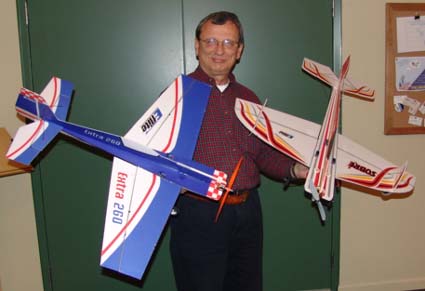
Rick Sawicki with his E-Flite Extra 260 and Sobre Photo taken at the January Midwest RC Society meeting. Upcoming February EFO Meeting The Thursday, February 7 EFO meeting will be held at Bill Brown's house. Country Club Village Condominiums 39603 Village Run Drive Northville, MI. Phone: 734 420-2733 Directions: 1. Proceeding South on US 275 and exit at 6 Mile Rd. 2. Go West on 6 MILE Rd to the first intersection with a traffic light, which is Haggerty Rd. 3. Turn left (South) onto Haggerty Rd and proceed about half a mile to the next traffic light. 4. Turn right (West) into Country Club Village Condominiums. 5. Keep Bearing Right on Village Run Drive and go 0.6 Mile then look to your left for the 1st house past the "Y" - intersection. Look for the open garage door with a model airplane on the trunk of a car. 6. Please enter through the side door inside the garage. The meeting will be in the basement shop. 7. The road ends at the next intersection. If you go too far, turn around ;-) Regards,
P.S. Let me order the weather for this one! And more from Rick Sawicki: 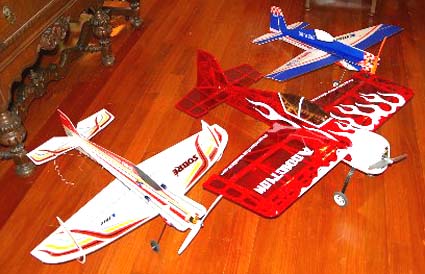 The larger red plane with flames is the Addiction from Australia. It is very light at 24 oz. with 500 sq.in. of wing area. It utilizes 64 separate pieces of carbon fiber to add strength while keeping it light. It takes a 3-cell 2100mAh Li-Po battery or even a 1000 mAh. The motor is also from Australia. I have tested the motor and the thrust is well over twice model weight. The other two are the latest flat foams from E-flight. They use a lot of carbon fiber rods for body bracing and wing and tail strength. One will be a Christmas present fro my son, whichever one he chooses, I'll take the other one. I hope to use them in the 23 Mile Dome in the future. A Good Read Bob Aberle put me on to this article. It is by Greg Covey and is on the Web at RC Universe. The article is titled, "What Motor Do I Use?" and includes the following sections;
EFLIOWA 07 Report
Ken, This is the 10th year of a little gathering of e-fliers that Jon McVay started. Jon and Tom McDonnell could not make it this year but we expect them next year.
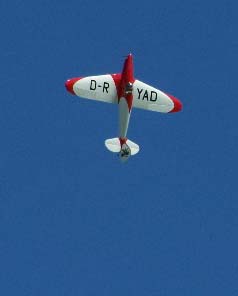
Keith's Stomo goes vertical We also enjoyed a couple local area modelers during the demo. Jim Porter has always been a fierce competitor with sailplanes and electric power. He showed us a couple of his competition models to highlight the differences in the models we enjoy. His demos could be titled "Gone in 20 seconds". Thank goodness he only uses about 10 seconds of power at a time. One of his planes uses somewhere near 150 amps at full throttle. It was also nice that he didn't try for duration or we would not be done yet. 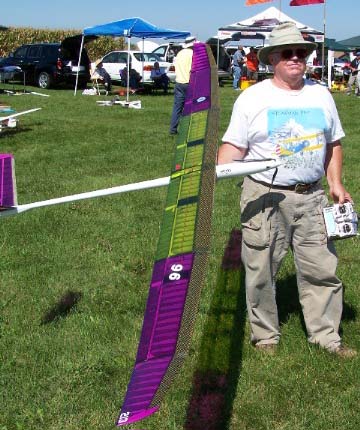
Jim Porter Darryl Miller also flew in our demo with his fantastic DC-3 in American Airlines colors. He made a very nice CD to play along with his flight and explain the incredible features and versatility of that famous airplane. The CD playing the 1940's music along with his smooth flying made for a ballet like performance. Darryl is an American Airline pilot but is a little too young to have flown the full size DC-3 so he had to make his own. 
Darryl with Plenny walking behind him There were a few vendors involved in the activities of the weekend. Sig Manufacturing's Bob Nelson flew a very nice electric conversion of their new Waco SRE ARF as well as their Dornier DO217. Doug Outlaw and Chris Sydor (spelling) of Hobbico flew several of their nice electrics and gave out many nice Futaba and Electrifly T-Shirts. Stan Zolodz of Z-Planes was there flying and selling all kinds of electric equipment. Bill of MidAmerica Hobbies, North Liberty, IA was also there with his great selection of electric goodies. We had a prize raffle that included donations from Sig, Dynamo Electrics, Z-Planes, and Castle Creations. Good times, Orville Keeping Li-Pos Warm at the Field in Winter
When I was talking with Keith Shaw recently, he said that he had purchased a Rubbermaid 5-Liter cooler. The unit not only cools, but heats as well. Keith's unit is listed on the source Web site as VEC222RB, 5-liter size. Meijer's had it normally at $31.99; his scratch-and-dent special was $22. Internet buyers beware! Don't assume that it is always cheaper. This is a good example as Lane's has it on sale for "only" $54 + $8 shipping.
Weights of Various Covering Materials (Over the years I have published covering weights several times in the Ampeer. Here's the latest I've found. KM) On an earlier thread I (Ron) posted some links for covering weights, they were compiled by independent testers (listed below) using a variety of measuring standards like Oz/sq/yard, Gr/Sq/Meter, etc, making it hard to compare them accurately. Well, I sent'em all through the online converter and changed them all to "Grams per Square Foot". Why? Because it's easy. Most kits and plans (in the U.S.) supply wing area in square inches and we all know that 1 square foot= 144 square inches, right? Anyway, here they are, lightest to heaviest from the top. Some of the sites differed by a small amount so I converted those to a "Range" and for a couple of samples there already was a "range" of weights, since some of the colors are heavier than others. For further descriptions see the links on the earlier post. www.wattflyer.com/forums/showthread.php?t=10278 Weights in Grams per square foot. Produce Bags (Thin Plastic, From Target) 0.53 (See Post # 18, 24)
Thanks again to Paul Daniels, Fatlion (Fritz Bien + Herm Perez), Barry's Aircraft Page, Warden, Twmaster, JoJa15, David Lewis and Modelflight.com!
Ron Gary Gullikson's Berkeley Aeronca Sedan
This one is my entry in the ongoing E-Zone Scale Electric Forum "Plan and Kit Build Fun Contest". I got the 1949 vintage Berkeley plans from Aerodyne Online. A modeler from Portland, OR furnished nice clear and complete Kinko color scans of part sheets from his old kit. I had Callie of Callie Graphics, Albuquerque, NM, make up the fuselage side and tail graphics and wing numbers.
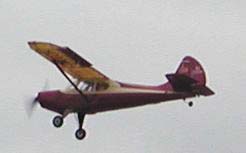 The Model maidened two days ago, will need some minor tweaking, but flew well. This model was one of my favorites from the late 50's as a free flight powered by Pee Wee .020, so I had to build an e-powered R/C version. Remember my Peashooter? Gary Gullikson
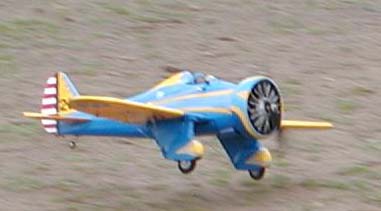 Nice Australian Spitfire
Stuart and I exchanged some info about storing Li-Po batteries. He also had these photos attached with the following information: "Spitfire is scratch-built, I much prefer to do this as half the enjoyment is in the building. I have a 48 inch ME109 on the building board at the moment.
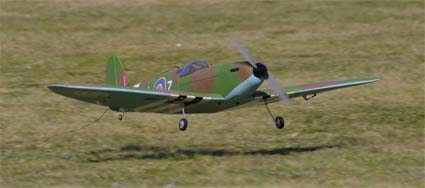 One Way to Draw Plans Using CAD
As I am writing up this issue of the Ampeer I am finishing up my plans for a design I call Son of Swallow. As noted last month, it is based on a 1986 Fred Reese design, but it is not his Swallow. I have made many, many changes, which I will note in an upcoming issue, but one of the major changes was the size, as well as structure, airfoil, incidence angles and more. It was suggested that I might share how I got the original plans into my computer for use with a CAD program, so this is a short step-by-step of how I did it.
Step 1: Either scan the 3-view/plan into the computer and save it to a format that your CAD program can import or get a 3-view/plan from the Internet. An Internet 3-view/plan will most likely be in .jpg or .gif format and have to be changed by the imaging program into a format your CAD program can use. Step 2: Open your CAD program and import the 3-view/plan.
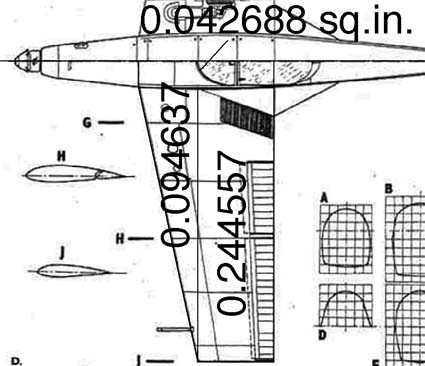
This shows the scanned image with the area figures.
You should note that I did not use the "triangle" at the rear of the wing, going to the fuselage, in computing the wing area for this example. Step 3: Draw in all of the outlines only of the 3-view/plan. Do not draw any structure at this time.  Save the file with a name like outline-zlin526. For this example, I only quickly did the top view, but all outlines should be in the outline file. Step 4: Once the original outline has been saved with its own file name, so that it can be used over to create different size models, do a save as and rename the file to something like zlin526-650, where the 650 represents the desired wing area in sq. in.
 This screen capture shows the "original drawing" near the center and the outline enlarged by 29.2. It also shows that I checked and found the area to be about 652 sq.in., which is what I wanted. Step 5: Add the structure. This is a LONG and TEDIOUS process! Be sure that you have read Keith Shaw's Talk to the EMFSO to learn how to do model structure correctly. You'll find that four part document here; members.aol.com/kmyersefo/page3.htm#TOP Step 6: After hours and hours of drawing and thinking and thinking and drawing, print your plans and build the plane. 
Son of Swallow Plans nearing completion After weeks and weeks of work, you may have a finished plan and templates similar to this one for Son of Swallow. If you follow the CAD designing steps in this issue, you could end up with a Zlin Z-526. ;-) 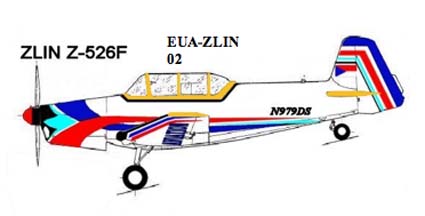 |
To Reach Ken Myers, you can land mail to the address at the top of the page. My E-mail
address is:
KMyersEFO@mac.com
EFO WEBsite: http://members.aol.com/KMyersEFO/
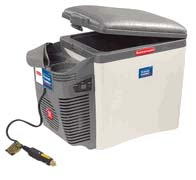
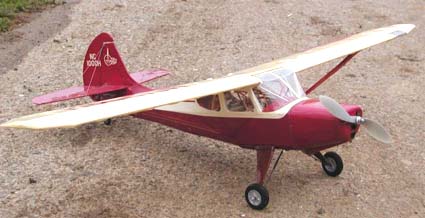
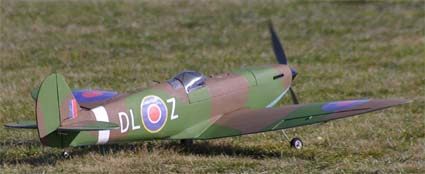
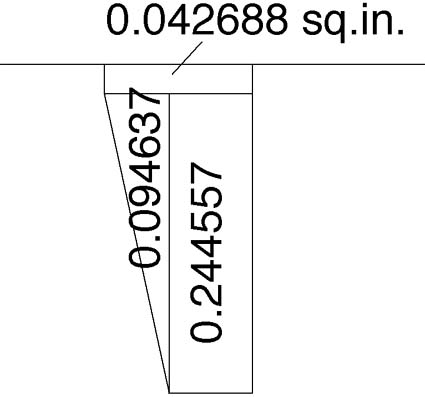 This shows the CAD drawing of the wing area, with the image hidden.
This shows the CAD drawing of the wing area, with the image hidden.